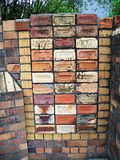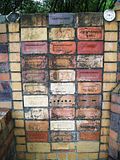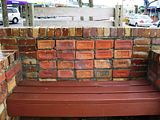Latest update: 6 November 2022.
Spontaneity, as my mum would say (I'm paraphrasing a bit here), is the spice of life. She was definitely into being spontaneous. So, when Tony from the
NZ Pottery forum mentioned in an email today that the late
Richard Quinn had mentioned that there were Aussie bricks in the New Lynn brickmakers memorial, erected by Rotary late last century -- I was intrigued. Intrigued enough to guess that there might be enough light for me to hop on a train today, and head into New Lynn town on a seek-and-find mission in Auckland twilight.
It's a nice memorial, still -- but also a victim of time and vandals. Many of the bricks are almost unreadable.
This is a piece of Carder Bros. pottery from Hobsonville/Limeburners Bay. What you can see of it behind the scratched perspex ... (although, around 2013-2015 since I first wrote this, the memorial has been smartened up, the perpex replaced) ...
The map and guide to West Auckland brickworks is in a sad state. Difficult to read (and historically inaccurate in places).
So ... are there Aussies in the memorial? (As at 17 January 2011 -- two Aussies have been identified). The list of those I noted tonight indicate that, when it came to gathering up the bricks, anything would do.
Known West Aucklanders
"ALF WAY, Bricklayer"
(Alf Way worked for A B Bricks Ltd. In 1984 he erected the stack and the walks of the memorial, and made this special brick.) *
Glenburn Avondale (St Georges Road)
Additional: James Archibald's first brickyard in the area dated from c.1873, on the western side of the Whau River. In 1882, he leased around 3 acres of a railway reserve in New Lynn from the Government, and operated a brickyard in that area until at least 1889-1890.
NZ Brick Co, New Lynn
This from dwing (see comments below)
"Talked to Ian Crum today and he confirmed that the 'NZ Brick Co, New
Lynn' brick was made by Albert Crums factory. The impressed design was
made with a hand carved roller, carved by Albert himself. Oil applied to
the roller made it non stick and last longer. Dated about 1915-1922ish.
Also stamping too many words in the frog was not a good idea hence the
abbreviated branding. The pipes made that time also seem to have the
same abbreviated words, I have an example here. So these bricks were not
fired in a Hoffmann type kiln, but rather a down draft salt kiln."
Crum (Great North Road, New Lynn)
W Hunt (first brickmaker at Glenburn)
Carder Bros & Co (see this
post)
BTA Brick, Tile (Auckland) Ltd ... A variation from the Avondale works at St Georges Road.
"It is said of the London clay that inevitably it spells ruin to the brickmaker not thoroughly familiar with its nature, for it is too strong —that is, it presents great difficulties in manufacture owing to its excessive shrinkage. Yet when properly worked, no bricks are better able to withstand the severe conditions to which bricks are subjected than those made from the London clay. A precisely similar difficulty characterises the clay deposits at Avondale. It has long been held by the local "wise heads" that these clays, and particularly those at the Avondale works, are not fit for the manufacture of bricks, yet it would on evidence appear that the unfitness was not attributable to any peculiarity the clay possessed. It has however been conclusively proven that, under capable management, by the abolition of "rule of thumb methods" and the substitution of expert knowledge that the huge deposits of clay on the property of
Brick, Tile, (Auckland) Limited, is just the very class of clay a competent and experienced management would desire for the production of a '"better brick." The new double pressed bricks now being made by the Company are branded
BTA. It may be interpreted by those who are uninitiated as "Beats Them All" or "Better Than Any" which would be a not altogether unexpected exclamation by those who see them for the first time, which are in substance solid facts. It will not be necessary to remind the architectural professor and the building trades generally of these facts. Those gentlemen of keen observation will at once say they are indeed good and if by the clean, smart appearance of the brick with its sharp arrises, the initials might pardonly be interpreted as "Beats Them all."' The BTA. is put on the brick merely that one and all may know it is the production of Brick, Tile, (Auckland) Limited." (
Auckland Star, 2 October 1920)
According to the
NZ brick database, J M Melville and J Fletcher purchased the J J Craig brickworks 16 July 1920, on behalf of BTA, Brick-Tile Auckland, then in the process of forming as a company. A Supreme Court ruling saw the name change to Glenburn Fireclay & Pottery Ltd 14 May 1923.
Henderson (at Te Atatu Peninsula) Note the backward "s".
Anthony (Tony) Petrie was born Ante Petric in 1882 on the island of Hvar in Dalmatia. He arrived in New Zealand around 1900, got involved in a feud near Kaitaia in 1905, ran foul of the law over that and served time at Waiotapu Prison Camp near Taupo. His sentence was reduced, and by 1911 he had become a gumbroker in Auckland, the start of a lifelong career in business.
Fast forward to 1924. He arranged the formation of a company called the
Waitakere Brick & Tile Co, near Waitakere Station, witnessing the signatures of the original subscribers and selling the company 50 acres of land in Waipareira parish for £3000 cash and £7000 in shares. However, this company went into voluntary liquidation in 1925.
Undaunted, Petrie went in for brickmaking enterprise No 2: the
New Era Pressed Brick and Tile Company, Ltd in 1927. The company was launched with £50,000 capital, made up of 100,000 shares, and things looked bright. Petrie was one of the main shareholders.
However ... this was at the start of the recession that slumped toward the depression in the following decade. A chap named Robert Ernest Odd, who had been contracted to build the works in 1927 and 1928, was unemployed by 1929, and went bankrupt. He claimed that the company owed him a total of £7000, for extras to the original building contract, plus loss of profit, and took them to court. By October, shares were being put up for sale in the newspaper classifieds, and in January 1930 Odd was advertising for "dissatisfied shareholders" in the company to contact him.
On top of this, a worker at the factory died when he fell into one of the machines in March 1930.
Although there was a spirited attempt at revival with the promotion of a debenture issue in November 1930, it really was the end. New Era was no more beyond that, although Petrie did use the works for a time making bathroom ware. I've also seen references to a "Waitakere brickworks", briefly, in 1937 and 1938. The building was still there in 1940, but all trace is gone today.
Tony Petrie died in 1969 at the age of 86. (Information from family history by Hazel Petrie, and Papers Past).
Laurie Bros(they were also in Newton originally)
Malam
Avondale B&P (at St Georges Rd, Avondale. See Glenburn)
GBP (Gardner Brothers & Parker, New Lynn.
See this post.) *
AB&T
(Auckland Brick & Tile. * They operated briefly in the 1880s on the east side of Te Atatu South)
J J Craig (see Glenburn)
Elsewhere
R & R Duder,Devonport, North Shore.
Robert Humphrey and Richard Wolloughby Duder, twin sons of Thomas Duder, operated a general store at the bottom of Church Street in Devonport from 1870. The brickworks in Ngataringa Bay (formerly Little Shoal Bay) began around 1882, as part of their land agency, building material supply, grocery and (later) bloodstock interests, and eventually a dedicated wharf was built for off-loading coal, and loading bricks for Auckland and other local wharves. The brickworks, however, had periods of activity, followed by inactivity. After first one brother died in 1923 and the other in 1933, the brickyard fell into disuse and ended up being totally dismantled and sold off by 1951.
Dolphin, Arch Hill
A better example of the Dolphin-style brick here, photographed on Clark street, New Lynn, 6 November 2022.

J Granger & Sons
(19 December 2011) Just recently found an article in the
Auckland-Waikato Historical Journal, April 1984, No. 44, pp. 21-24 on John Granger and his Whitford brickworks.
According to the article (by Rev R Hattaway), Granger arrived in Auckland in 1865, from Nottingham, on the ship
King of Italy with his wife and family. After trying his luck on the Thames goldfields, he returned to his trade back in England, brickmaking (apparently, he had managed a brick and tile factory on the Duke of Portland's estate.) He at first managed Spencer's brickworks at Buckland's Beach from 1869-1878, then when Spencer sold the works Granger purchased the equipment and moved to Turanga Creek (the former name for Whitford). The site of the first brickworks was selected on the east side of the creek, with the means of transporting the product ready to hand: by the creek, and then the harbour to Auckland. He settled his family there that year.
From the article,
"... a private road extended from the public road past the front of the house, to a wharf above which the brickworks and kilns were situated. Here the bricks and tiles were conveyed in a trolley on rails from the kilns to the wharf where they were loaded into the boat. There were two trolleys connected to a wire rope that revolved around a drum at the kilns. As one trolley full of bricks proceeded to the wharf, it automatically hauled the empty trolley up the incline to the kilns. The wharf was also used by local residents from Waikopua and near by, travelling by steamer to and from Auckland, until well into the nineteen-twenties."
In the early 1890s, Granger shifted his works to a new site upstream. Here he employed some 23 to 25 mostly local men. The bricks impressed with "Granger" in the frog were so marked with a hand-operated machine. His bricks were used in the construction of the Whitford Brick School (1894), the first Auckland Blind Institute building,
Karangahake railway tunnel (1900-1905), and the inner walls of the
Auckland Ferry Building. (1912) A wet winter put paid to more of Granger's brick being used for this latter contract -- his bricks couldn't be dried in time.
Competition from the up-and-coming New Lynn brickworks, along with a fall-off in demand for field tiles (most of the surround areas of Mangere, Papatoetoe, East Tamaki and Pukuranga by the 1920s being now well-drained), spelled the decline of Granger's brickworks. Shortly after May 1926, the machinery was dismantled and carted away. A farmer then took possession of the remaining buildings, demolishing the kilns and using the bricks from them to metal his gateways and pave the stockyard.
Rev Hattaway, at the time of writing his article, counted seven buildings in Whitford and at least two in Howick constructed with Granger bricks.
Peter Hutson & Co (Wellington) *
According to Progress, 1 September 1906, the brickworks began c.1872, and was taken over by Peter Hutson & Co c.1891. New brickworks were erected at Newtown some time before 1906.
Peter Hutson seems to have been a bricklayer and lime dealer in the early 1880s, selling bricks on the side. He was in partnership with John Moore; when that dissolved by March 1885, he continued to trade under the name Peter Hutson & Co. By 1891, he was Wellington's sole agent for Wilson's hydraulic lime -- and also went bankrupt. By the close of the year, however, he traded his way out of the reefs, Peter Hutson & Co advertising as "cement, lime and pottery merchants".
The business seems to have faded out during World War I.
Garratt, Enfield, Australia.
Tony, from
NZ Pottery, has found the following: "In
Turn of the First Clay - our brickmaking heritage by Allan M Hackett, 2009 there are two photos of Garratt bricks. One has two rounded edges so perhaps used to cap a fence or for some other architectural feature and has the impressed words GARRATT and ENFIELD - the author dates it circa 1910. The other is a standard shape with GARRATT in a rectangular frog wth rounded corners - dated circa 1890s.")
H&G
(More information from Tony: "In
And So We Graft from Six to Six - the brickmakers of New South Wales, Warwick Gemmell, Angus & Robertson, 1986 - there's an entry "Hart and Gallagher [1886 - 1912], New Canterbury Road, Petersham. The firm was a prominent pottery manufacturer as well as producer of bricks. Semi-plastic bricks impressed H & G were probably made by this firm.")
Austin, Sydenham (Christchurch)
Tony from the NZ Pottery forum located a Trade Me listing today (17 January 2011) for a Austin, Sydenham brick, said to have been linked to Austin, Kirk & Company of Christchurch. Probably not completely accurate, but close enough.
Walter Austin & Henry Bland Kirk began making earthenware drain pipes early in 1872 in Colombo Street south, Christchurch. By 1874, they were advertising for brickmakers. In 1876, they were in Tuam Street. In 1886, they were part of the collection for brickmakers in Christchurch uniting together to form the first New Zealand Brick, Tile and Pottery Company (not to be confused with
Crum and Friedlander's later northern enterprise.
The amount of support accorded by the public to the newly-formed New Zealand Brick, Tile and Pottery Company has been so liberal that it has been decided to commence operations at the Company's works at once. These works compise the four manufactories formerly carried on by Messrs Austin and Kirk, W. Neighbours, J. Brightling and J. Goss. It appears the members of the abovementioned firms have taken up 350 £5 shares in addition to the 1177 paid-up shares which they have received for the purchase of their premises and stock-in-trade. A large number of shares have also teen subscribed for by the public, and applications for others are still coming in freely. By the amalgamation of the business of the four factories, the saving effected on the former cost of working will, it is estimated, be very considerable. Judging from their former experience, the members of the firms concerned have every confidence in the success of the undertaking.
Christchurch Star 1 February 1886
The first company didn't last long, and by the 1890s, Kirk and Austin were no longer partners. Indeed, they were anything but: Austin’s earthenware factory was at Sydenham as at August 1895 when Kirk sued him for patent infringement. (
ChCh Star 19 August 1895) It's possible that Austin made bricks as a sideline, and therefore his work in that field could be quite uncommon.
W Mouldey
William Mouldey operated Bricks & Pipes Ltd in Palmerston North until his death in 1941, according to
this site. He appears to have started in the first decade of the 20th century at least. He built houses as well, such as
this one in Featherston Street (sadly now demolished.)
More notes from Tony:
"It looks as if the W Mouldey brick has "P N" on it with the N, possibly inadvertently, reversed. A quick google suggests that Brick and Pipes Ltd owned the Hoffman Kiln from 1919 until kept firing it until 1959.
NZHPT have a pdf file on it accessible via
http://citylibrary.pncc.govt.nz/historic-places-in-palmerston-north.html
It says the Brick and Pipes office is also preserved.
http://www.historic.org.nz/>TheRegister/RegisterSearch/RegisterResults.aspx?RID=194
which references a link back to Jack Diamond: 'Report on the Hoffman Oblong Continuous Kiln, Brick and Pipes Ltd., 615 Featherston Street, Palmerston North', J. Diamond, December 1980, NZHPT File 12020-013
A book has been written about it: 'Nine Thousand Bricks a Day; The Hoffman Kiln and the Brickworks of Palmerston North', Lundy, J., Palmerston North, 2005"
Clayton & Co, PATENTED
Henry Clayton (1814-1884), born in Marylebone, Middlesex, England, built his "Patented hand-driven brick and tile making machines" from the mid 1840s, and they ended up going all over the British Empire and America. His father, also named Henry, may have initially started the business making agricultural equipment. Henry jnr won a first class prize for his brick machinery at London's Great Exhibition in 1851, which would certainly have helped with its promotion. He obtained a US Patent in 1855. After Clayton's death in 1884, the business was run by Francis Howlett for a time, but then in 1902 the business was acquired by Brightside Foundry and Engineering Co of Sheffield, and the Clayton Howlett machinery shifted north. Brightside underwent reorganisation in the mid 1920s, and production of Clayton's brick & tile machines ceased from that time.
Much more here:
Henry Clayton & Co. - Manufacturers of Patented Brick Making Machines
And -- thumbnails of the collection.














































































